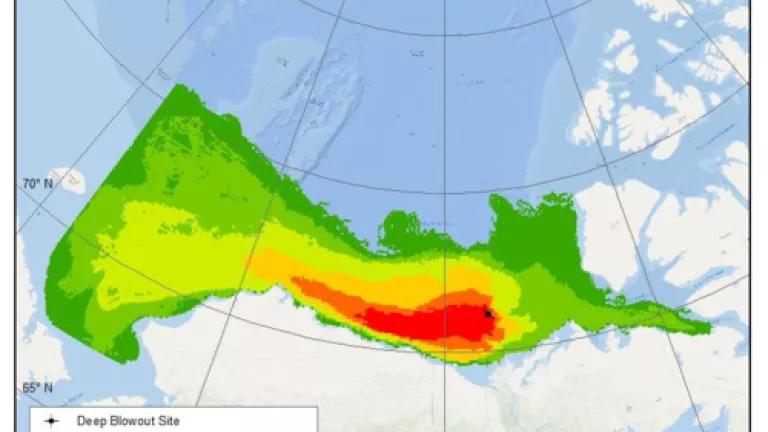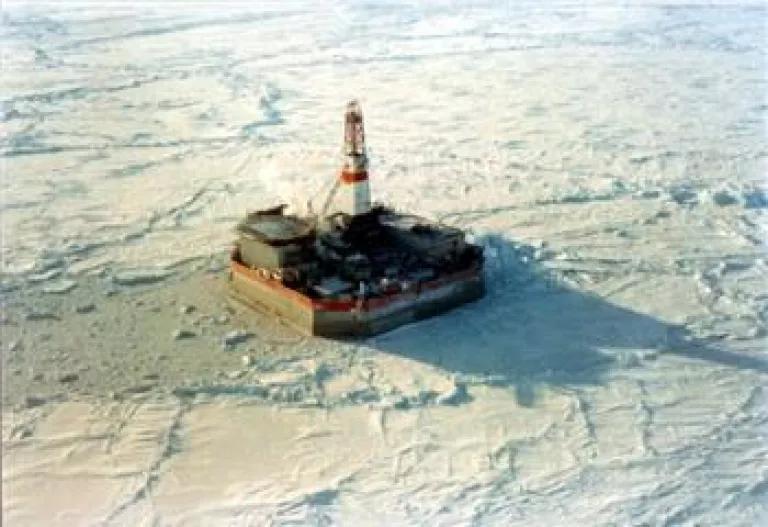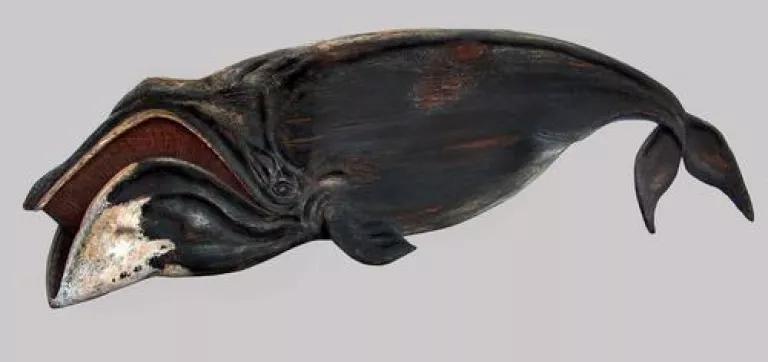Arctic on Notice: A Barge Adrift at Sea and Spill Modeling by the World Wildlife Fund Show the Extreme Risks of an Arctic Ocean Oil Spill

This week, news of the fate of an unmanned barge set adrift in Canada's Beaufort Sea in October finally resurfaced. Where had it gotten to after breaking from its tow north of Tuktoyaktuk, Northwest Territories? It turns out that after being stuck in the ice over winter, the barge is now off the Russian coast, having drifted nearly 1,400 miles in just five months. That distance is remarkable. As Canada's National Energy Board (NEB) considers undisclosed and untested offshore oil and gas well safety measures proposed for operations in the Canada's Beaufort Sea, the potential fate and impact of an under ice oil spill in the Beaufort Sea remains a serious open question with a growing body of evidence pointing to a truly troubling answer.
Last fall, World Wildlife Fund Canada (WWF) provided a first glimpse of just how problematic a late-season oil spill in the Beaufort Sea could be. In a major report modeling the impacts of an oil spill in Arctic waters, WWF and its partner RPS Applied Science Associates, considered the likely behavior and impact of four different types of spills in the Beaufort Sea: tanker, pipeline, shallow water, and deep water. Under each scenario analyzed, oil is expected to spread across significant swaths of the Arctic Ocean. In the worst cases, spilled oil could travel more than 1,000 kilometers from its source with the potential for impacts to shorelines and waters in Canada, the U.S. and Russia. This week's news makes clear that 1,000km was only a conservative estimate of just how far spilled oil from these proposed operations could go. It also highlights once again that deep water oil and gas exploration in Arctic waters creates unnecessary environmental risks that could decimate an entire region's ecosystem along with the traditions and livelihoods of its indigenous population.
Surface oiling predicted by RPS ASA under a late season, deep water blowout scenario.
A short history of exploration with no payoff and limited success
Until recently, the Beaufort Sea remained ice covered for most of the year, making offshore resource development nearly impossible. In the 1970s, and continuing through the late 1980s, numerous exploratory wells were drilled in shallow waters in the Canadian Beaufort Sea. Though oil was discovered, high costs, extreme operating conditions, declining oil prices, and discovery of only small, "widely scattered reserves," led to a decline in industry interest. The short era of exploration ended for good in 1990 when the newly created Environmental Impact Review Board found that the Government of Canada and Gulf Oil, with its proposed Kulluk drilling program, were unprepared for a major oil spill event in the Beaufort Sea.

Molikpaq drilling vessel in Canada's Beaufort Sea, circa 1984.
Though ice in the Beaufort Sea has continued to recede as climate change accelerates, the challenges and risks faced by the offshore oil and gas industry remain. The Beaufort Sea is now ice free for a month or two each year, but it is completely ice covered for eight. At the same time, memories of recent offshore drilling disasters, falling world oil prices, and increased international attention on activities that are driving climate change make renewed exploration as risky and unnecessary as it was in the 1970s and 80s. The problems with offshore oil and gas exploration in Arctic waters have been encapsulated by Shell's disastrous experience in the U.S. Chukchi and Beaufort Seas where accidents and challenging conditions have led to massive capital spending and constant delays. Indeed, as the U.S. contemplates leasing new exploration rights in the U.S. Beaufort Sea, more than 50% of current U.S. exploration leases are being relinquished by the oil industry, marking a mass exodus of interest in Arctic offshore exploration.
Still, in an apparent search for the Holy Grail of frontier oil reserves, today's Canadian operators are now looking to move farther offshore into deeper, more treacherous waters.
Open vs. icy waters
RPS ASA's modeling of potential Beaufort Sea oil spills illuminates an interesting reality: the risks and impacts posed by an oil spill in the Beaufort Sea change depending on whether the spill takes place in open water vs. icy water. Though one might assume that open water conditions would lead to fewer impacts, the truth is the opposite and more complex. As highlighted in WWF's report, any spill from a deep water operation (the type currently being proposed by industry and reviewed by the NEB) will likely lead to major harmful environmental impacts.
For an open water spill early in the drilling season (i.e., the type of spill where the most tools for remediation are available and operating conditions are the most ideal), the report finds "a high probability that shorelines along the U.S. coast of the North Slope and Point Barrow would become moderately to heavily oiled." In ice covered waters, or in waters where ice is beginning to form, impacts to shorelines are lessened due to the presence of landfast ice. However, longer response times and entrapment of oil in ice lead to massive dispersion of oil throughout the Arctic Ocean along with the risk of contamination from toxic dissolved aromatics.
Impacts to the marine environment
With the potential for the massive spread of oil throughout the Arctic region comes the potential for significant environmental impacts. Under the four key scenarios modeled for a deep water well failure, RPS ASA's models show shoreline oiling ranging from 300-1,800 kilometers in length, with the most oiling occurring following an early season blowout. This means that the critical habitat of numerous Arctic species, including polar bear, migratory birds, ringed seals, and bearded seals would be directly impacted. Further, because oil would be expected to disperse widely below the surface, a blowout could lead to major impacts to iconic marine species such a bowhead and beluga whales, as well as the numerous species of fish upon which indigenous communities depend.

Bowhead whale populations are dependent on the Beaufort Sea for survival and play a central role in indigenous whale hunting traditions.
Unacceptable Risks
Media outlets were quick to pick up on RPS ASA's and WWF's work. No doubt this is because the results laid bare an essential truth about resource development in Arctic offshore areas: it is accompanied by the extraordinary risk for widespread ecological destruction. And this destruction is not limited to Canadian waters. Indeed, with proposed projects planned in areas less than 200 kilometers east of the U.S.-Canada border, impacts to Alaska's North Slope and Arctic National Wildlife Refuge could occur due to the predominantly westward movement of oil from a spill. These trans-boundary risks highlight the need for increased international attention on Arctic resource development issues, especially as countries like Canada consider making aggressive and risky moves that place the entire region at risk.

